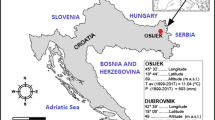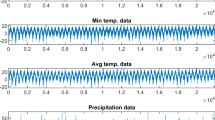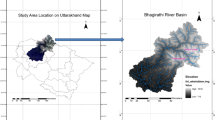Abstract
Climate change occurs in the atmosphere over a long period due to the influence of the sun, oceans, clouds, ice, land, and living organisms on each other. This research used the Principal Component Analysis (PCA) model compounded with Vector Autoregressive Integrated (VARI) called the PCA-VARI model to determine climate change. PCA reduces correlated climate data to uncorrelated data expressed as main components containing a linear combination of initial variables. In the time series model, a non-stationary multivariate comprises more than two variables that influence each other, using differencing processes. A variety of two models was used simultaneously to forecasting future climate data. Analysis of climate parameters uses ten measurements variable located in five areas, namely Lembang, Bogor, Tasikmalaya, Sukabumi, and Indramayu, for twenty years, using POWER NASA Agro-climatology datasets. The methodology follows the Knowledge Discovery in Databases (KDD) in data mining for integrated PCA with VARI and post-processing using visualization by Impulse Response Function (IRF). The result of forecasting in the PCA-VARI model using IRF in the next six months showed that the effect of location climate on the response of other regions with changes in standard deviation is similar to adjacent locations. Meanwhile, the responses obtained varied based on the observation time for the five areas that are not close.
Access this chapter
Tax calculation will be finalised at checkout
Purchases are for personal use only
Similar content being viewed by others
References
Kishimoto, R., Shimura, T., Mori, N., Mase, H.: Statistical modeling of global mean wave height considering principal component analysis of sea level pressures and its application to future wave height projection. Hydrol. Res. Lett. 11(1), 51–57 (2017)
Washington, B.J., Seymour, L.: An adapted vector autoregressive expectation maximization imputation algorithm for climate data networks. Wiley Interdiscip. Rev. Comput. Stat. 12(6), e1494 (2020)
Mal, S., Singh, R.B., Huggel, C., Grover, A.: Introducing linkages between climate change, extreme events, and disaster risk reduction. In: Mal, S., Singh, R., Huggel, C. (eds.) Climate Change, Extreme Events and Disaster Risk Reduction. Sustainable Development Goals Series, pp. 1–14. Springer, Cham (2018). https://doi.org/10.1007/978-3-319-56469-2_1
Pretis, F.: Econometric models of climate systems: the equivalence of two-component energy balance models and cointegrated VARs (2015)
Mamipour, S., Yahoo, M., Jalalvandi, S.: An empirical analysis of the relationship between the environment, economy, and society: results of a PCA-VAR model for Iran. Ecol. Ind. 102, 760–769 (2019)
Han, J., Kamber, M., Pei, J.: Data Mining Concepts and Techniques, 3rd edn. Elsevier Inc., Massachusetts (2012)
Niu, J., et al.: A comparative study on application of data mining technique in human shape clustering: principal component analysis vs. factor analysis. In: 2010 5th IEEE Conference on Industrial Electronics and Applications, pp. 2014–2018. IEEE, June 2010
Cerón, W.L., et al.: A principal component analysis approach to assess CHIRPS precipitation dataset for the study of climate variability of the La Plata Basin, Southern South America. Nat. Hazards 103(1), 767–783 (2020)
Chandra, E., Ajitha, P.: PCA for heterogeneous data sets in a distributed data mining. In: Proceedings of the Fourth Annual ACM Bangalore Conference, pp. 1–4, March 2011
Munandar, D., Ruchjana, B., Abdullah, A.: Principal component analysis-vector autoregressive integrated (PCA-VARI) model using data mining approach to climate data in the West Java Region. Barekeng J. II. Mat. Ter. 16(1), 099–112 (2022)
Yu, Y., Wang, D.: Similarity study of hydrological time series based on data mining. In: Atiquzzaman, M., Yen, N., Xu, Z. (eds.) BDCPS 2020. AISC, vol. 1303, pp. 1049–1055. Springer, Singapore (2021). https://doi.org/10.1007/978-981-33-4572-0_150
Du, X., Zhu, F.: A novel principal components analysis (PCA) method for energy absorbing structural design enhanced by data mining. Adv. Eng. Softw. 127, 17–27 (2019)
Snedecor, G.W., Cochran, W.G.: Statistical Methods. Iowa State University Press (1989)
Singh, T., Ghosh, A., Khandelwal, N.: Dimensional reduction and feature selection: principal component analysis for data mining. Radiology 285(3), 1055 (2017)
Johnson, R.A., Wichern, D.W.: Applied Multivariate Statistical Analysis, 6th edn. Pearson Prentice Hall, New Jersey (2007)
Anton, H., Rorrers, C.: Elementary Linear Algebra, 11th edn. Wiley, Hoboken (2014)
Box, G.E.P., Jenkins, G.M.: Time Series Analysis Forecasting and Control. Holden-Day. Inc. (1976)
Dickey, D., Fuller, W.A.: Distribution of the estimators for time series regressions with a unit root. J. Am. Stat. Assoc. 74(366), 427–431 (1979)
Brockwell, P.J., Davis, R.A.: Introduction to Time Series and Forecasting, 2nd edn. Springer, New York (2002). https://doi.org/10.1007/b97391
Box, G.E.P., Cox, D.: An analysis of transformations. J. R. Stat. Soc. B.26(2), 211–252 (1964)
Di Asih, I.M., Rahmawati, R.: Vector autoregressive model approach for forecasting outflow cash in Central Java. J. Phys. Conf. Ser. 1025(1), 012105 (2018)
Nalita, Y., Rahani, R., Tirayo, E.R., Toharudin, T., Ruchjana, B.N.: Ordinary least square and maximum likelihood estimation of VAR (1) model’s parameters and it’s application on Covid-19 in China 2020. J. Phys. Conf. Ser. 1722(1), 012082 (2021)
Granger, C.W.J.: Investigating causal relations by econometric models and cross-spectral methods. Econometrica 37(3), 424–438 (1969)
Chan, J.C., Shi, J.E.: Application of projection‐pursuit principal component analysis method to climate studies. Int. J. Climatol. J. R. Meteorol. Soc. 17(1), 103–113 (1997)
Shaharudin, S.M., Ahmad, N., Zainuddin, N.H., Mohamed, N.S.: Identification of rainfall patterns on hydrological simulation using robust principal component analysis. Indones. J. Electr. Eng. Comput. Sci. 11(3), 1162–1167 (2018)
Shahin, M.A., Ali, M.A., Ali, A.B.M.S.: Vector autoregression (VAR) modeling and forecasting of temperature, humidity, and cloud coverage. In: Islam, T., Srivastava, P., Gupta, M., Zhu, X., Mukherjee, S. (eds.) Computational Intelligence Techniques in Earth and Environmental Sciences, pp. 29–51. Springer, Dordrecht (2014). https://doi.org/10.1007/978-94-017-8642-3_2
POWER NASA. https://power.larc.nasa.gov/. Accessed 21 May 2022
WIKIMEDIA. https://upload.wikimedia.org/wikipedia/commons/b/b9/Geocultural_regions_of_West_Java.svg. Accessed 21 May 2022
Gabriel, A.G., Santiago, P.N.M., Casimiro, R.R.: Mainstreaming disaster risk reduction and climate change adaptation in comprehensive development planning of the cities in Nueva Ecija in the Philippines. Int. J. Disaster Risk Sci. 12(3), 367–80 (2021)
Newth, D., Gooley, G., Gunasekera, D.: Socio-economic analysis of climate services in disaster risk reduction: a perspective on pacific SIDS. Front. Environ. Sci. 9 (2021)
Acknowledgments
The authors are grateful to the Rector of Universitas Padjadjaran, who provided financial support to disseminate research reports under the Academic Leadership Grant year 2022 and Studies Center of Modeling and Computation Faculty of Mathematics and Natural Sciences Universitas Padjadjaran. Gratefully thank the Head of the National Research and Innovation Agency (BRIN), who has supported the funding for the Doctoral Program by Research 2022. The authors are also grateful for the discussion on social media analytics through the RISE_SMA project funded by the European Union from 2019–2024.
Author information
Authors and Affiliations
Corresponding author
Editor information
Editors and Affiliations
Rights and permissions
Copyright information
© 2023 IFIP International Federation for Information Processing
About this paper
Cite this paper
Munandar, D., Monika, P., Salsabila, A.B., Helen, A., Abdullah, A.S., Ruchjana, B.N. (2023). Data Analytics of Climate Using the PCA-VARI Model Case Study in West Java, Indonesia. In: Gjøsæter, T., Radianti, J., Murayama, Y. (eds) Information Technology in Disaster Risk Reduction. ITDRR 2022. IFIP Advances in Information and Communication Technology, vol 672. Springer, Cham. https://doi.org/10.1007/978-3-031-34207-3_18
Download citation
DOI: https://doi.org/10.1007/978-3-031-34207-3_18
Published:
Publisher Name: Springer, Cham
Print ISBN: 978-3-031-34206-6
Online ISBN: 978-3-031-34207-3
eBook Packages: Computer ScienceComputer Science (R0)





